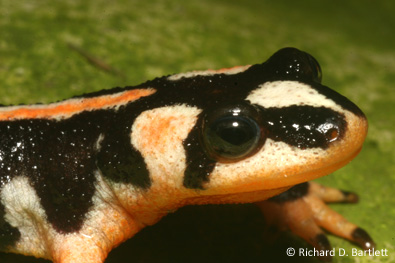The little-known Luristan newt (also called Kaiser’s spotted newt) is a highly attractive EDGE amphibian from Iran. Its striking colouration is thought to provide a warning to potential predators of its toxicity. Sadly, however, the remarkable appearance of the Luristan newt has also resulted in this species becoming highly prized in the pet trade, where collectors will spend up to £200 to own one. Now Critically Endangered in the wild, the combination of over-collection and habitat loss is generating a very uncertain future for this beautiful creature.
Luristan newts are extremely sensitive to environmental change because they live in arid, marginal conditions where severe droughts can have a grave impact on population numbers as these newts depend on spring-fed streams for breeding. Worsening the precarious situation of the species in the wild, the Luristan newt is becoming increasingly popular in the international pet trade, where individuals caught in the wild are being illegally exported out of Iran and are finding their way into global markets.
A recent article published in the Independent highlighted the grim reality that the Luristan newt faces in the wild. Michael McCarthy, Environment Editor and Kevin Rawlinson stated:
“The demand has been such that the wild population, found only in four streams of Iran’s Zagros Mountains, was reduced by 80 per cent between 2001 and 2005 alone, and is now classed as Critically Endangered. It is estimated that fewer than 1,000 mature individuals remain.”
Sadly for the newt, its rarity contributes to its collectability as some amphibian enthusiasts enjoy keeping unusual and beautiful species in their homes. Although certain amphibians can be captive bred to meet demand from the pet trade, the economic value of the Luristan newt also drives illegal collection from the wild. The risk of over-collection to the survival of this species in the wild is immense so we urge potential collectors to consider the consequences of buying a Critically Endangered species that could have been taken from a dwindling wild population. Amphibians can, after all, be driven to extinction by such incidents of over-collection from the wild.
Linking in with the current CITES meeting in Qatar, Michael McCarthy and Kevin Rawlinson added:
“Over the next few days, the 175 Cites member states meeting in Doha, including Britain, will consider whether to take a more proactive approach to regulating the online trade in endangered species. This is likely to include the creation of an international database, scientific research to gauge the correlation between wildlife loss and online trade, and closer collaboration with Interpol, the international law enforcement agency.”
To read the full article, please click here.
.jpg)
.jpg)
